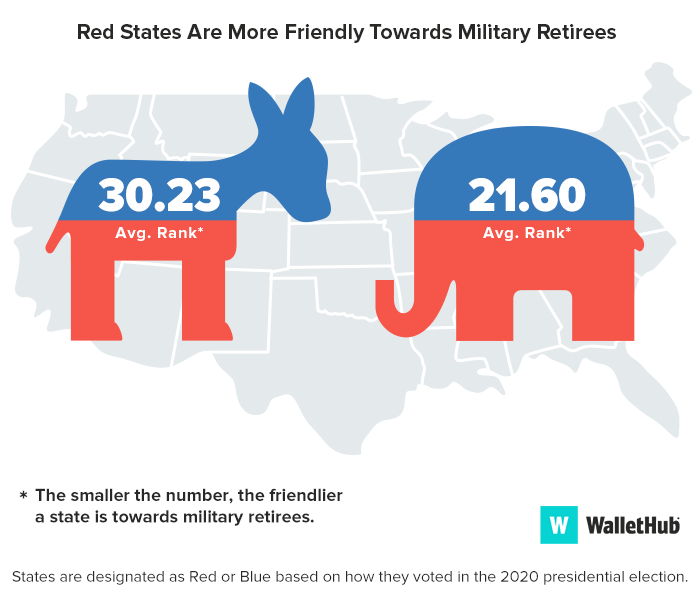
With May being Military Appreciation Month and Memorial Day approaching, the personal-finance website WalletHub today released its report on 2023’s Best & Worst States for Military Retirees. To help our troops plan their years after service, WalletHub compared the 50 states and the District of Columbia across 28 key indicators of retirement-friendliness toward veterans. The data set ranges from job opportunities for veterans to housing affordability to quality of VA hospitals.
Coming in at number 1 overall for military retirees is our state of Florida. Although not number one in any of these individual categories, a high enough ranking to put Florida on top.
Military Retirement in Florida (1=Best; 25=Avg.):
- 20th – Veterans per Capita
- 6th – Number of VA Health Facilities per Number of Veterans
- 8th – Veteran Job Opportunities
- 18th – % of Veteran-Owned Businesses
- 6th – Number of VA Benefits-Administration Facilities per Number of Veterans
Florida is near the top for Economic Environment for Military Retirees as well as high scores for Quality of Life.
Room for improvement here in the Sunshine State would be Health Care. Floridavets.org reports "The VA operates seven medical centers in Florida. They are located at Bay Pines, Gainesville, Lake City, Miami, Orlando, Tampa and West Palm Beach. The VA also operates approximately 50 Outpatient Clinics for health care and more than two dozen Vet Centers for counseling throughout the state." Clinics include those here in Southwest Florida in Fort Myers and Naples.
According to MyArmyBenefits, "Florida offers special benefits for Service members, Veterans and their Families including homestead tax exemptions, state employment preferences, education and tuition assistance, vehicle tags, as well as hunting and fishing license privileges."
Finally, where do all the other states stack up? Well, according to this study by WalletHub, military retirees may want to steer clear of the states on the West Coast.
Main Findings
Best States for Military Retirees
| Overall Rank | State | Total Score | Economic Environment | Quality of Life | Health Care |
|---|---|---|---|---|---|
| 1 | Florida | 61.14 | 6 | 3 | 19 |
| 2 | South Carolina | 60.82 | 15 | 2 | 9 |
| 3 | Virginia | 60.45 | 4 | 5 | 17 |
| 4 | Minnesota | 59.22 | 18 | 36 | 1 |
| 5 | Connecticut | 57.78 | 35 | 21 | 2 |
| 6 | New Hampshire | 57.47 | 14 | 8 | 12 |
| 7 | Maryland | 57.31 | 23 | 1 | 29 |
| 8 | South Dakota | 56.99 | 13 | 25 | 7 |
| 9 | North Carolina | 56.51 | 5 | 16 | 21 |
| 10 | North Dakota | 55.11 | 1 | 28 | 30 |
| 11 | Alaska | 54.87 | 10 | 10 | 35 |
| 12 | Alabama | 54.60 | 3 | 17 | 37 |
| 13 | Oklahoma | 54.05 | 8 | 6 | 43 |
| 14 | Louisiana | 53.89 | 11 | 27 | 22 |
| 15 | Wyoming | 53.56 | 9 | 4 | 50 |
| 16 | Arizona | 52.98 | 21 | 7 | 38 |
| 17 | Missouri | 52.92 | 22 | 22 | 23 |
| 18 | Massachusetts | 52.88 | 26 | 49 | 4 |
| 19 | Michigan | 52.82 | 19 | 40 | 8 |
| 20 | Montana | 52.54 | 25 | 18 | 24 |
| 21 | Kansas | 52.34 | 37 | 20 | 10 |
| 22 | Arkansas | 52.27 | 24 | 23 | 25 |
| 23 | Pennsylvania | 52.10 | 41 | 38 | 5 |
| 24 | Ohio | 51.94 | 30 | 41 | 6 |
| 25 | Idaho | 50.90 | 40 | 19 | 15 |
| 26 | West Virginia | 50.62 | 7 | 44 | 34 |
| 27 | New Jersey | 50.37 | 31 | 14 | 36 |
| 28 | Kentucky | 50.17 | 28 | 35 | 16 |
| 29 | Utah | 49.67 | 2 | 34 | 49 |
| 30 | Hawaii | 49.65 | 38 | 11 | 39 |
| 31 | Illinois | 49.48 | 34 | 39 | 11 |
| 32 | Texas | 49.31 | 27 | 31 | 33 |
| 33 | Delaware | 49.22 | 48 | 12 | 14 |
| 34 | Indiana | 48.71 | 20 | 43 | 32 |
| 35 | Colorado | 48.61 | 44 | 15 | 27 |
| 36 | Iowa | 48.37 | 17 | 32 | 41 |
| 37 | Wisconsin | 48.30 | 46 | 29 | 13 |
| 38 | New York | 48.19 | 50 | 47 | 3 |
| 39 | Maine | 48.03 | 36 | 37 | 20 |
| 40 | Nebraska | 47.44 | 47 | 26 | 18 |
| 41 | Rhode Island | 46.95 | 12 | 46 | 42 |
| 42 | Georgia | 46.85 | 32 | 24 | 44 |
| 43 | Tennessee | 46.03 | 16 | 48 | 40 |
| 44 | California | 45.63 | 51 | 9 | 28 |
| 45 | New Mexico | 45.17 | 43 | 13 | 47 |
| 46 | Washington | 43.17 | 33 | 30 | 51 |
| 47 | Vermont | 42.01 | 49 | 42 | 31 |
| 48 | Mississippi | 41.91 | 45 | 33 | 46 |
| 49 | Nevada | 41.67 | 39 | 45 | 48 |
| 50 | District of Columbia | 41.63 | 29 | 50 | 45 |
| 51 | Oregon | 38.73 | 42 | 51 | 26 |
Note: With the exception of “Total Score,” all of the columns in the table above depict the relative rank of that state, where a rank of 1 represents the best conditions for that metric category.
Veterans per Capita
- 1. Alaska
- 2. Maine
- 3. Montana
- 4. Virginia
- 5. Wyoming

- 47. District of Columbia
- 48. California
- 49. Utah
- 50. New York
- 51. New Jersey
VA Health Facilities per Number of Veterans
- 1. New York
- 2. California
- 3. Wyoming
- 4. Montana
- 5. Texas

- 47. Washington
- 48. South Carolina
- 49. District of Columbia
- 50. Delaware
- 51. Rhode Island
% Homeless Veterans
- 1. Arkansas
- 2. Virginia
- 3. New Mexico
- 4. South Dakota
- 5. North Dakota

- 47. Washington
- 48. Nevada
- T-49. California
- T-49. Oregon
- T-49. District of Columbia
Job Opportunities for Veterans
- 1. North Dakota
- 2. District of Columbia
- 3. South Dakota
- 4. New Jersey
- 5. Kentucky

- 47. Texas
- 48. Maine
- 49. Mississippi
- 50. California
- 51. Nevada
Housing Affordability
- 1. Iowa
- 2. Nebraska
- 3. Kansas
- 4. Indiana
- 5. Ohio

- 47. Massachusetts
- 48. Oregon
- 49. New York
- 50. Hawaii
- 51. California
% Veteran-Owned Businesses
- 1. Virginia
- 2. South Carolina
- 3. Hawaii
- 4. Arkansas
- 5. New Hampshire

- 47. New Jersey
- 48. District of Columbia
- 49. California
- 50. Illinois
- 51. New York
Blue States vs. Red States

Methodology
In order to determine the best and worst states for military retirement, WalletHub compared the 50 states and the District of Columbia across three key dimensions: 1) Economic Environment, 2) Quality of Life and 3) Health Care.
We evaluated those dimensions using 28 relevant metrics, which are listed below with their corresponding weights. Each metric was graded on a 100-point scale, with a score of 100 representing the most favorable conditions for military retirees. For metrics marked with an asterisk (*), we measured the “number of veterans” by the square root of the veteran population in order to avoid overcompensating for small differences among states, considering Veterans Administration (VA) facilities have not increased proportionally with the number of veterans.
We then determined each state and the District’s weighted average across all metrics to calculate its overall score and used the resulting scores to rank-order our sample.
Economic Environment – Total Points: 33.33
- State Tax on Military Pension: Quadruple Weight (~6.35 Points)
- Tax-Friendliness: Double Weight (~3.17 Points)
Note: This metric is based on WalletHub’s “Tax Rates by State” report. - Share of Veteran-Owned Businesses: Full Weight (~1.59 Points)
- Dollars in Defense Department Contracts per Capita: Full Weight (~1.59 Points)
- Job Opportunities for Veterans: Triple Weight (~4.76 Points)
- State Authorization for Veterans’ Preference in Private Hiring: Full Weight (~1.59 Points)
Note: This binary metric considers the presence or absence of a state statute authorizing private employers to implement a veteran-employment preference without vulnerability to claims of discrimination. - Job Growth (2022 vs. 2021): Double Weight (~3.17 Points)
- Military Bases & Installations per 100,000 Veterans: Full Weight (~1.59 Points)
- Total VA Expenditure per Number of Veterans: Full Weight (~1.59 Points)
- Presence of State Help for Returning Veterans: Full Weight (~1.59 Points)
Note: This binary metric considers the presence or absence of veteran transition programs & commissions in a state. - Presence of Academic Credit for Military Service: Full Weight (~1.59 Points)
Note: This binary metric considers the presence or absence of state legislation recognizing the varied skills and knowledge veterans acquire by counting it toward college credit. - Housing Affordability: Double Weight (~3.17 Points)
- Cost-of-Living Index: Full Weight (~1.59 Points)
Quality of Life – Total Points: 33.33
- Share of Veterans: Full Weight (~3.17 Points)
- Share of Veterans Not Receiving SNAP: Full Weight (~3.17 Points)
- Share of VA Benefits-Administration Facilities per Number of Veterans*: Double Weight (~6.35 Points)
- Quality of Public University System: Full Weight (~3.17 Points)
Note: This metric is based on WalletHub's “College & University Rankings.” - Arts, Entertainment & Recreation Establishments per Capita: Half Weight (~1.59 Points)
- Share of Population Aged 40 & Older: Full Weight (~3.17 Points)
- Share of Homeless Veterans: Double Weight (~6.35 Points)
- Idealness of Weather: Double Weight (~6.35 Points)
Note: This metric is based on WalletHub’s “Cities with the Best & Worst Weather” ranking.
Health Care – Total Points: 33.33
- Number of VA Health Facilities per Number of Veterans*: Full Weight (~3.70 Points)
- Federal, State, Local & Private Hospitals per Capita: Full Weight (~3.70 Points)
- Quality of VA Hospitals: Triple Weight (~11.11 Points)
Note: This metric includes VA hospital performance star rating from the U.S. Department of Veterans Affairs’ “Strategic Analytics for Improvement and Learning” (SAIL) performance improvement tool. - Physicians per Capita: Full Weight (~3.70 Points)
- Mental Health Counselors per Capita: Full Weight (~3.70 Points)
- Veteran Suicide Rate: Full Weight (~3.70 Points)
- Presence of Veteran-Treatment Courts: Full Weight (~3.70 Points)
Note: This binary metric considers the presence or absence of veteran-treatment courts, programs that provide treatment and mentoring services to veterans with mental-health and substance-abuse problems in order to keep them out of the criminal justice system and help stabilize their lives.
Sources: Data used to create this ranking were collected from the U.S. Census Bureau, Bureau of Labor Statistics, Military Officers Association of America, Military OneSource, USAspending.gov, U.S. Department of Veterans Affairs, National Conference of State Legislatures, Center on Budget and Policy Priorities, Council for Community and Economic Research, U.S. Department of Housing and Urban Development, Indeed and WalletHub research.
What is Memorial Day?
Memorial Day is a federal holiday in the United States for honoring and mourning the U.S. military personnel who have died while serving in the United States armed forces. It is observed on the last Monday of May.
So while this article focuses on the Vets, let us also take time to remember those who made the Ultimate Sacrifice.





